Newsletter 16
February 2019
Editors view
Dear friends, dear colleagues, dear all,
Many people are putting in hard work to organise the upcoming CIPA International Symposium in a successful way. This 27th edition of the symposium will take place in Ávila, Spain from 1-5 September 2019. This newsletter features one item completely devoted to this important event for CIPA. Pleas note that the call for papers is still open:
- 22 Feb 2019: deadline for Full Papers to be submitted in the ISPRS Annals;
- 4 March 2019: deadline for Abstracts to be submitted in the ISPRS Archives.
For the first time, the CIPA expert members will elect the new executive bodies during this International Symposium. Soon, you will be informed for this process.
This summer, already the 6th CIPA summer school is about to happen. After traveling around in Europe, the summer school will touch down in Korea this year and take place in the city of Gyeongju from 14 to 20 July 2019. To that end, CIPA is collaborating with local stakeholders such as KAIST and ICOMOS-Korea.
We also want to draw your attention on the fact that we have managed to put all the past workshops proceedings online. Most of those were accessible on the previous version of our website, but the website update from two years ago meant that all those links had to be reestablished. At this moment, all proceedings from 2017 back until 1999 can be downloaded. We even managed to put the complete 1991 proceedings online. If anyone would have a digitised version of the missing proceedings, we would be very happy to receive it since our goal is it to make all CIPA proceedings freely available.
As always, we remain open to any possible newsletter contribution and welcome every proposal to make our cherished organisation even more visible.
Enjoy reading our new e-newsletter,
Stratos Stylianidis, Geert Verhoeven
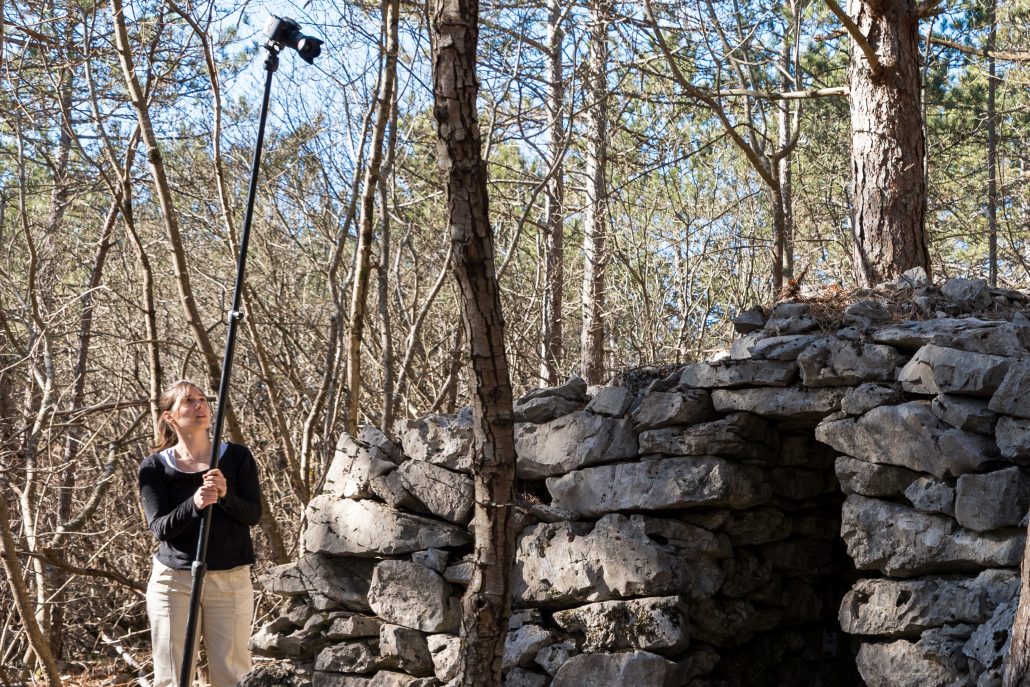
Efstratios Stylianidis, Geert Verhoeven
Geert Verhoeven
stratos@geoimaging.com.cy
Glimpses from the northern lights of cultural heritage
In the summer of 2018 ICOMOS-Finland arranged a seminar Interpreting Shared Heritage through Time as well as an ICOMOS Europe Group Meeting in Helsinki associated with the European Year of Cultural Heritage 2018. The committee of Shared Built Heritage, a scientific committee of ICOMOS, participated in the seminar. Finland belonged to a Baltic tour of the international committee.
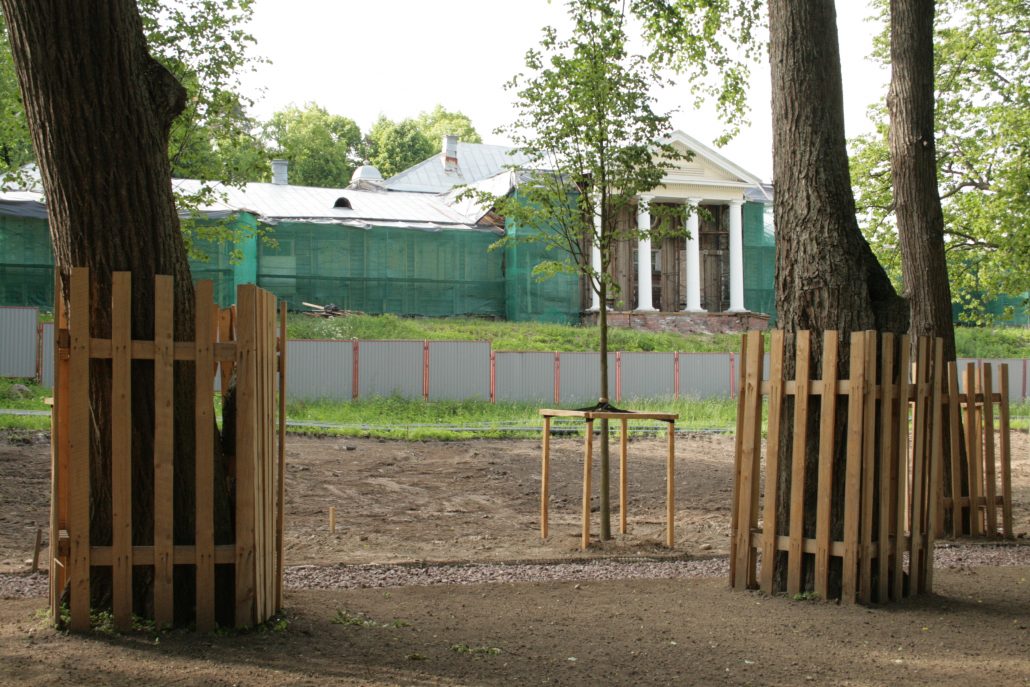
Figure 1. The Monrepos manor and park under restoration near Vyborg in Russia. The building follows the Palladian ideals applied into wooden architecture. Photo: Minna Silver.
The central arena of the meetings in Finland was the World Heritage Site of Suomenlinna (Viapori, Sveaborg), an 18th century fortress built during the Swedish occupation of Finland. It consists of fortified islands in front Helsinki that for centuries have formed a guarding post between the East and West. Now the area is a recreation site with museums, a living place of people and an active garrison.
Presentations and workshops of the seminar dealt with the participation and sharing the heritage according to the Faro Convention. The Governing Body of Suomenlinna co-operated in the seminar, and its results will be compiled for a scientific report and a model of participation to protect and preserve a world heritage site. Over 70 participants of the seminar and meetings from all over the world had also an opportunity to privately visit architect Alvar Aalto’s ateljé in a social gathering. Aalto was a modernist who followed ideas from Bauhaus developing them further and applying to Northern milieu and the use of wood.
The committee of Shared Built Heritage included in its tours Vyborg, a Medieval town near the Russian Finnish border and continued further to St Petersburg. In Vyborg the central interests were the restoration works of the old town and the nearby situating Monrepos park (Fig. 1.). Vyborg and Monrepos used to belong to Finland before the II World War, but they have also been part of Russia during various episodes of history. The Monrepos park from the 18th century and the present manor house in its core dating from the beginning of the 19th century represent Neoclassical ideals and are currently under a restoration facilitated by the aid of the World Bank.
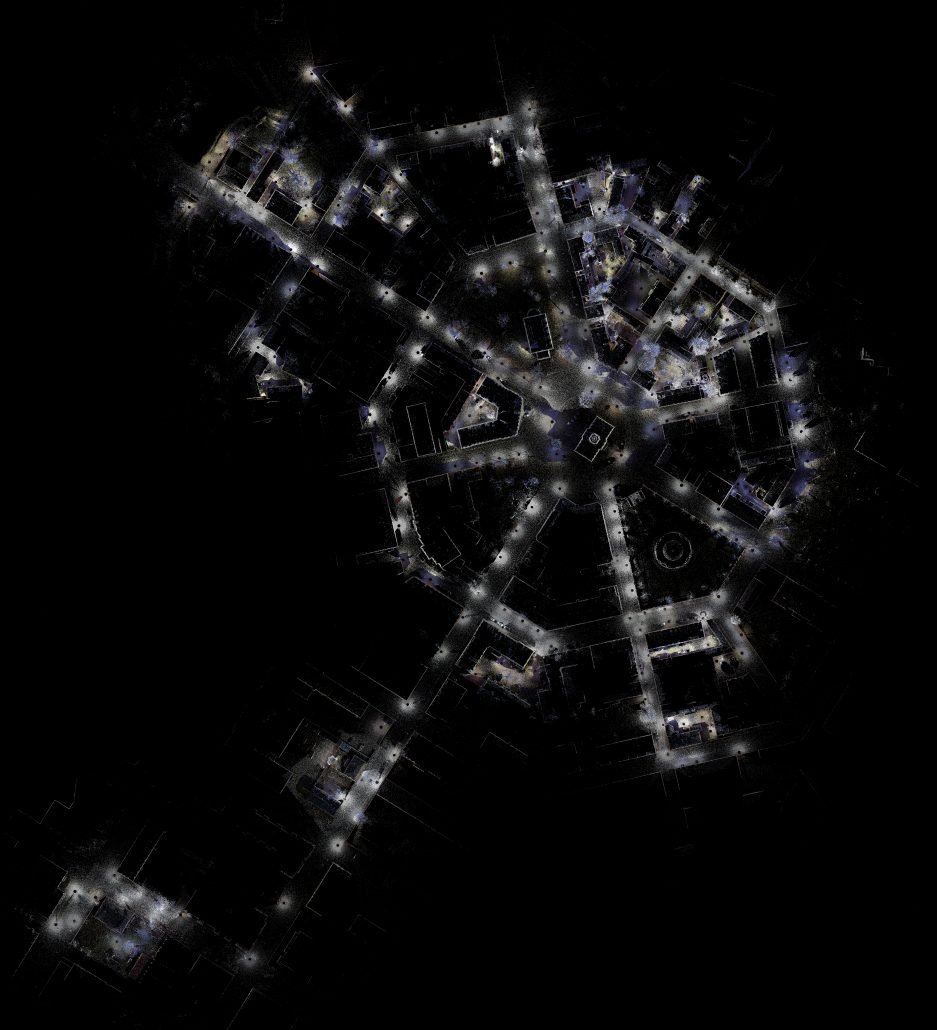
Figure 2. A laser scanned town plan of Hamina in Finland. Courtesy: Jorge Fernandez.
An international summer school in digital documentation Unveiling the Hidden Hamina took place in the late summer in the town of Hamina near the Finnish Russian border. The inhabitants of the town are actively engaging in the preservation of their surroundings and supported the documentation work of the summer school. The area of Hamina now belongs to Finland but has been part of Russia in various occasions. The town has connections to Vyborg and its architectural traditions. Hamina has a unique circular town plan (Fig. 2.) that finds parallels in Renaissance Italy and Germany.
Both Hamina and Vyborg follow in their fortification systems Marshal Vauban’s French ideals. The towns still have military areas with garrisons from the 18th and 19th centuries. The fortifications have greeting gates: Hamina has a Vyborg gate whereas Vyborg has a Hamina gate. The similar planning of star-like bastions in Hamina and Annencrown in Vyborg applies to Suomenlinna, the World Heritage Site. All the fortified sites need vigilance in their protection, preservation and restoration work.
The site of Monrepos is a place of unique beauty following the nature-style English garden planning and the Italian influenced Neo-Palladian building style that is applied to wooden architecture in Northern conditions. Sergey Gorbatenko, President of ICOMOS St Petersburg and Vladimir Tsoi, Director of Vyborg medieval castle, were guiding the international visitors in the summer. The case of the Monrepos park and the undertakings in its renovation have alarmed the attention of the international heritage community.
Vyborg also was further the site of an international conference in preservation and restoration of small historical towns that took place in Russia in October at the Vyborg Library originally planned by Alvar Aalto and restored in co-operation between Russians and Finns (Fig. 3.). Experts from different parts of Russia, including the one associated to the World Heritage Site of the Kizhi island with unique wooden architecture, presented their work during the conference. Reviving various historical sites and towns have been the focus both in Russia and Finland; the wooden architecture and its preservation have become the interest of locals, and inhabitants participate also in invigorating traditional carpentry and painting works.
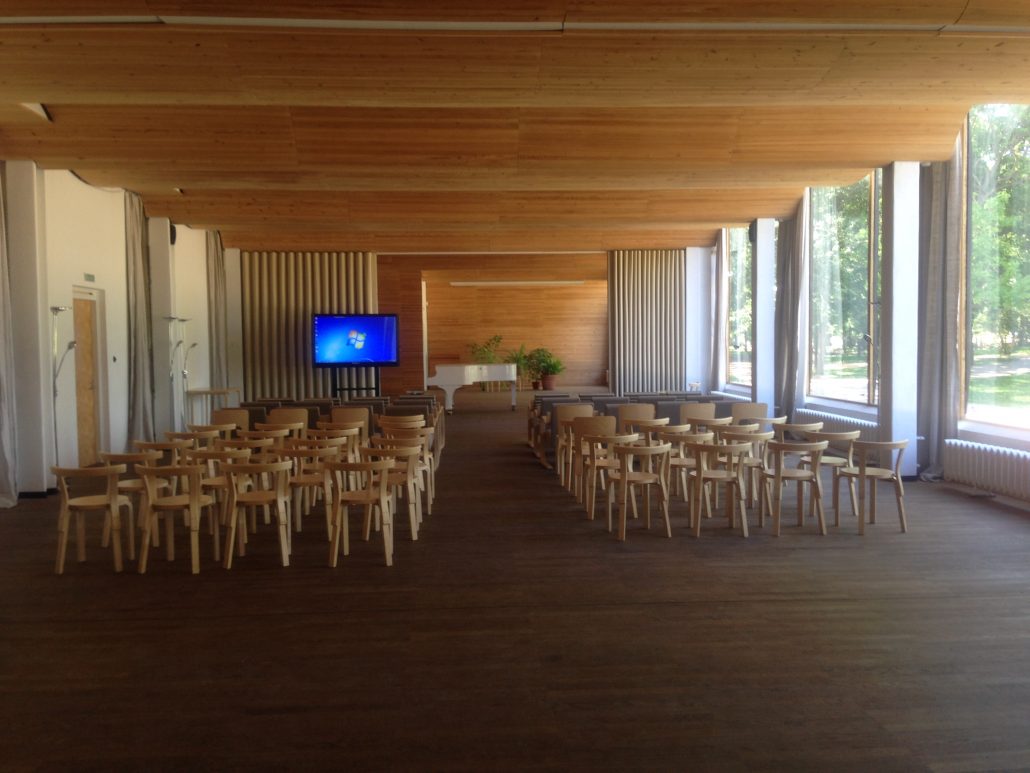
Figure 3. The lecture hall of the Vyborg Library planned by Alvar Aalto and restored in co-operation between Russians and Finns. Photo: Minna Silver.
Minna Silver
mlonnqvi61@hotmail.com
Blue Shield Georgia – CIPA Winter School. Keeping it Modern
January 16-19, 2019, Tbilisi (Georgia)
The Blue Shield Georgia – CIPA Winter School for Heritage Documentation
A very important aspect of architectural conservation is documentation – understanding the structure, recording its dimensions, conditions, and creating graphic representations for communication. But most importantly, capturing the spirit of the place in order to communicate its significance and values. Therefore, there must be a focus on education, especially with the next generation of architects, engineers, historians, and conservators. In addition, many young professionals at the beginning of their careers need practical exposure and work experience with the challenges of using advanced tools and techniques.
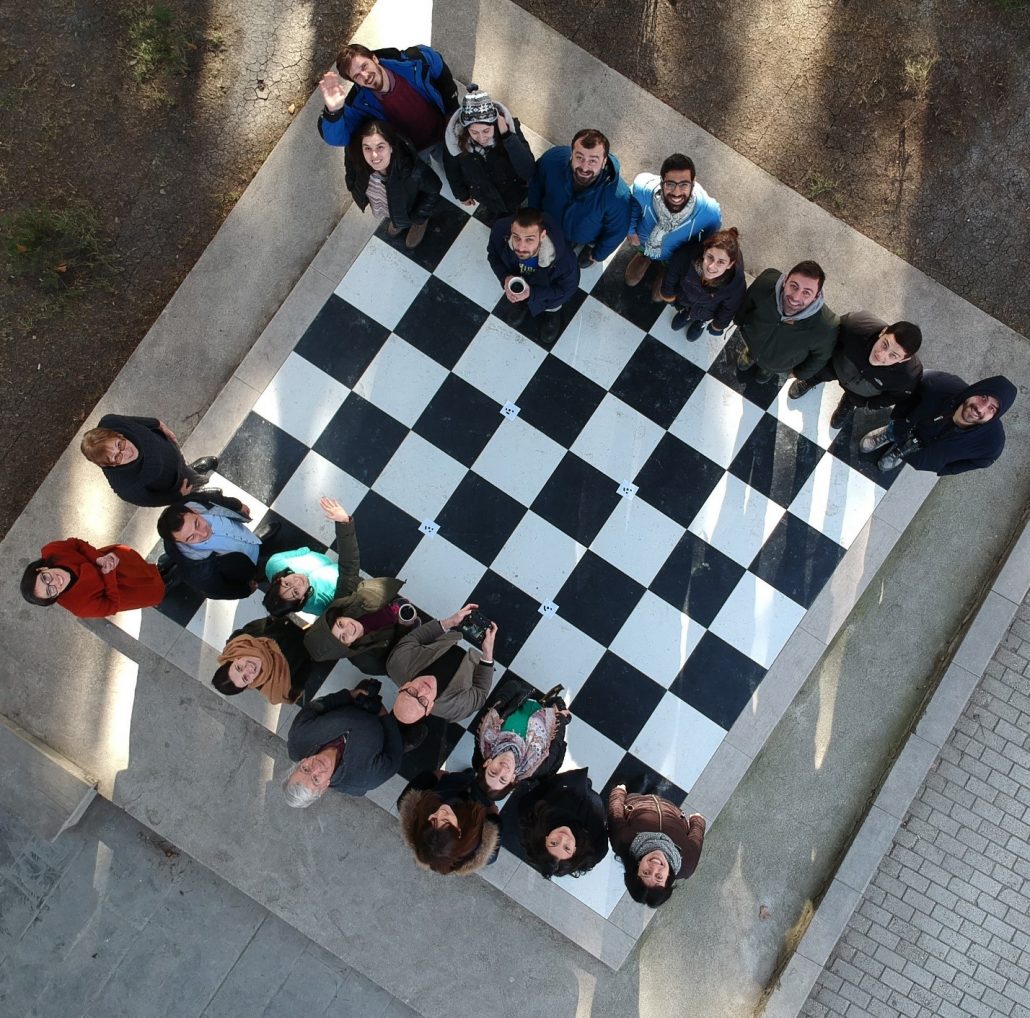
Participants at the Blue Shield Georgia CIPA Winter School (Eppich)
During the third week of January, 2019, CIPA, in partnership with Blue Shield Georgia, held a Winter School workshop. During the course, fifteen participants explored a variety of technologies and techniques including a discussion on the appropriate selection and use of these tools and their cost-benefits. These tools included photogrammetry, laser scanning, advanced photography, use of endoscopes, microscopes, and crack monitoring. Participants came from a number of institutions including Ilia State University, Georgian Technical University, and the Tbilisi State Academy of Arts and included a few young professionals employed in state and private institutions. This workshop was held under the larger project grant to Blue Shield Georgia by the Getty Foundation’s Keeping it Modern Initiative. This very first Winter School follows on the success of the previous CIPA Summer Schools.
The training took place en situ at the Tbilisi Chess Palace and Alpine Club. This structure is one of the unique examples of late Soviet Modernist Architecture. Commonly referred to as the Tbilisi Chess Palace, the building was conceived to serve two, at that time, very popular sports in Georgia – chess and mountaineering and continues to house both sports federations from its opening until today.
Tbilisi building was designed by two architects: Vladimir (Lado) Aleksi-Meskhishvili (1915-1978) and Germane Gudushauri (born 1939) and opened in 1973 in Kirov (today’s Vere) Park in the center of Georgia’s capital city – Tbilisi. The architects worked closely with “Sameuli” (group of three) collective – Alexander Slovinsky (1935), Oleg Kochakidze (1935-2017) and Yuri Chikvaidze (1934-2004) who worked on the interior decoration of the building.
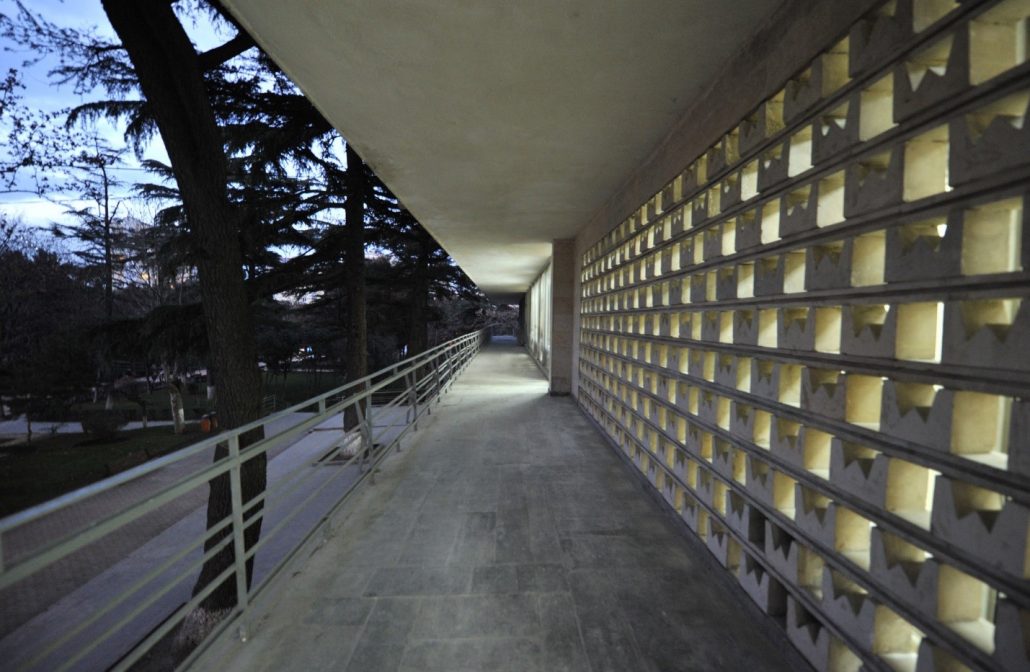
Tbilisi Chess Palace and Alpine Club (Eppich)
The building stands out as significant because it was designed and constructed to celebrate Georgia´s achievements and not reinforce the collective or Soviet authority. It has been the home and training grounds for many of Georgia´s chess champions, particularly women, who in the 1970s held the world chess champion title for over 30 years. The building is said to be dedicated to five-time world champion, Grandmaster Nona Gaprindashvili, who in 1962, at the age of 21, became the world chess champion for the first time. It is still popular with the residents of Tbilisi today and is a place of frequent gathering. It is unlike other Soviet period buildings in Tbilisi in that it is not stylistically Brutalism, but adorned with natural wood and is light and open, nestled within the surrounding park.
Blue Shield Georgia
Georgian National Committee of the Blue Shield (GNCBS) was founded in 2013 and is recognized by Blue Shield International, as one of its national committees worldwide. Like Blue Shield International, the Georgian National Committee aims at protecting cultural heritage from natural disasters and from the damages incurred in the event of armed conflicts, raising awareness on and facilitating implementation of both protocols of The UNESCO Hague Convention in Georgia, facilitate creation of risk preparedness and management plans for cultural heritage protection, raising awareness on threats to cultural heritage. In addition, the goal of the Georgian National Committee of the Blue Shield is a cooperation with the network of international Blue Shield, establishing partnerships with local and international organizations working on protection of cultural heritage. Blue Shield Georgia will be administering the Keeping it Modern initiative at the Tbilisi Chess Palace and Alpine Club in cooperation with the Getty Foundation. More info can be found here.
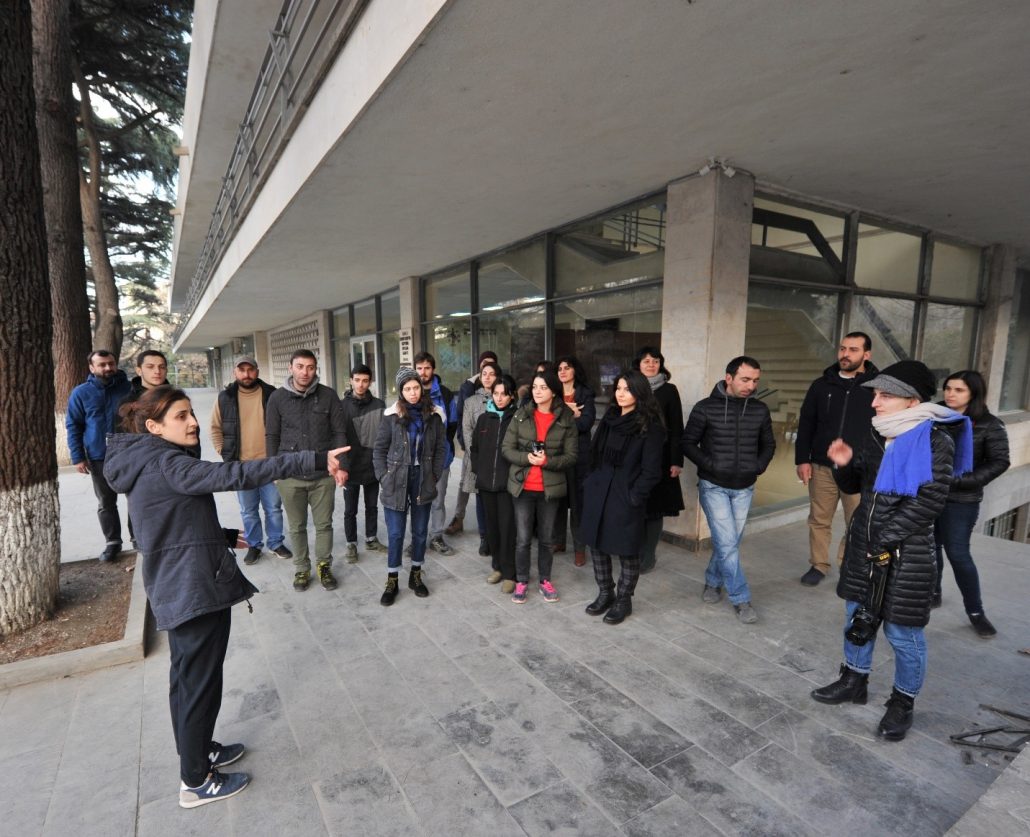
Conservator Lela Ninoshvili and Architect Lasha Shartava lead the participants on a tour of the building (Eppich)
The Winter School was also supported by:
- The Tbilisi City Municipality;
- NSERC Create Heritage Engineering Program and Carleton Immersive Media Studio (CIMS) at Carleton University;
- National Technical University Athens, School of Rural and Surveying Engineering- Photogrammetric Lab;
- The Aristotle University of Thessaloniki, Faculty of Engineering, School of Spatial Planning & Development, Thessaloniki, Greece;
- Heritage Development.
A video of this winter school can be found here.
Rand Eppich and Manana Tevzadze
randeppich@gmail.com
ICOMOS ISC’s Joint Meeting / ICOMOS2020GA Sydney
In 2017, CIPA hosted the CII joint meeting in New Delhi, during the ICOMOS 2017 General Assembly and International Symposium, which is the major ICOMOS event taking place every three years. This joint meeting received more than 40 papers and was attended by approx. 100 ICOMOS members. The three ISC Presidents actively participated in the lively discussions of this successful event www.cii2017.org.
After several discussions and considerations, CIPA decided to take advantage of the experience in ICOMOS 2017 General Assembly in India and organize a parallel ISC joint meeting during the 2020 General Assembly and International Symposium, which will take place in Sydney, Australia.
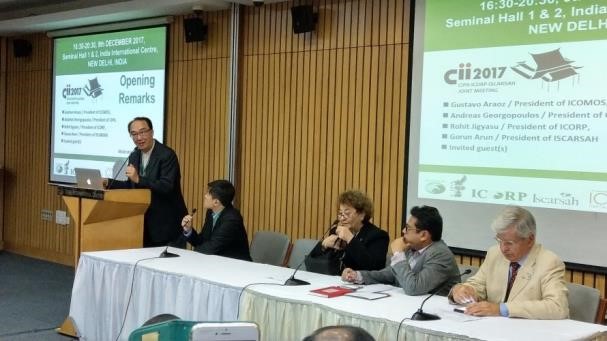
Opening remarks, CII joint meeting 2017
CIPA plans to invite 3 ISCs ICOPR (International committee on Risk Preparedness), ISCARSAH (International committee on Analysis and Restoration of Structures of Architectural Heritage) and ISCEAH (International committee on Earthen Architectural Heritage) to have a half day’s joint meeting. Alex Yen on behalf of CIPA will organize and coordinate this event with Mario Santana being the co-organizer.
The proposal will be announced soon and looking forward for the support from all the CIPA members.
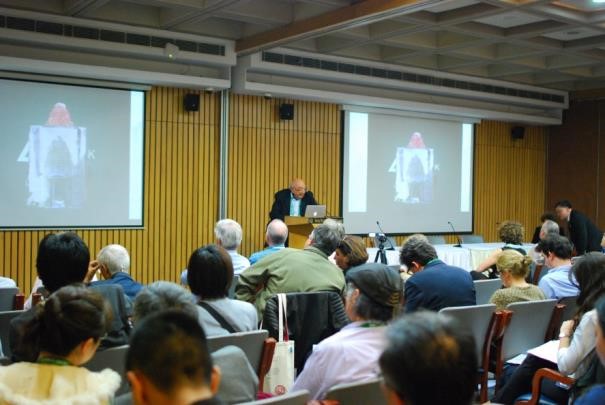
Keynote speech, CII joint meeting 2017
Alex Yen
alexyen@cute.edu.tw
Digital Heritage 2018
26-30 October 2018, San Francisco (USA)
Digital Heritage Conferences are a series of global events organized by the informal confederation of all organizations concerned in one way or another with Cultural Heritage. CIPA is one of them. The idea was conceived in Milan in 2012 and since then two such events took place in Marseille (2013) and in Granada (2015). This was the third in the series organized in San Francisco by Prof. Lon Addison. The decision was taken in summer 2017 after a vote by the participating organizations. Note that in the meantime (Oct. 2017) Eurographics have decided not to participate in this global event any more.
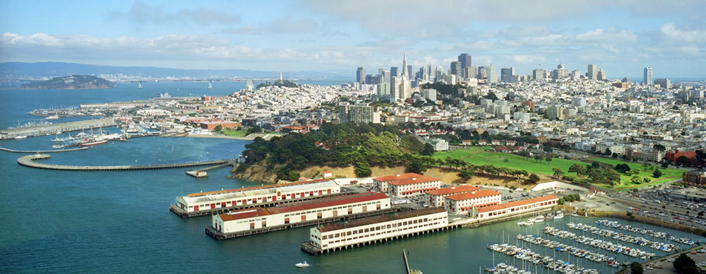
Digital Heritage 2018 in San Francisco, 26-30 October 2018, was designed to be a leading global event on digital technology for documenting, conserving and sharing heritage, from monuments & sites, to museums & collections, libraries & archives, and intangible traditions & languages. Featuring keynotes from cultural leaders & digital pioneers, a tech expo, research demos, scientific papers, policy panels, best practice case studies, hands-on workshops, plus tours of technology and heritage labs. It was scheduled for 5 days, combining 18 federating events, with many talks, in 4 amazing venues, 50,000 sqft of expo space and 3 technical tours.
The focus of the conference was on Culture and technology domains from computer science to cultural preservation, archaeology to art, architecture to archiving, museums to musicology, history to humanities, computer games to computer graphics, digital surveying to social science, libraries to language, and many more.
Digital Heritage 2018 was staged at the Fort Mason Center for the Arts as well as in nearby museums and monuments. Fort Mason, a historic former naval facility, sits on the San Francisco Bay with stunning views of the Golden Gate Bridge.
At the same time 2 conferences and 15 special events were held in conjunction with DH2018. The International Society on Virtual Systems and Multimedia VSMM 2018 – 24th International Conference and the Pacific Neighborhood Consortium PNC 2018 – 25th Conference & Joint Meetings.
The special events included:
- Computer Applications & Quantitative Methods in Archaeology – CAA Special Symposium;
- The Int’l Council on Monuments & Sites/Int’l Society for Photogrammetry & Remote Sensing – ICOMOS/ISPRS CIPA Special Session;
- Int’l Conference on Remote Sensing in Archaeology, Space2Place 2018 Special Session on Remote Sensing for Archaeological Heritage in Conflict Zones;
- ICOMOS Int’l Scientific Committee for Interpretation & Presentation of Cultural Heritage (ICIP); ICOMOS ICIP Session on Technology for Interpretation: Challenges & Potential; ICOMOS ICIP Workshop on Evolving Technologies for Interpretation; ICOMOS ICIP Session on Digital for Archaeological Collections;
- Association of Canadian Archivists, ACA Special Session on Archives;
- California State Parks, CalParks Special Session on 3D Digital Preservation & Best Practices;
- Rijksmuseum, 2+3D Photography Special Session;
- Centre for Architecture, Urbanism & Global Heritage, Nottingham Trent Univ. & Middle East Virtual Heritage Network, 5D Virtual Heritage of Medieval Culture Special Session;
- EU E-RIHS Project and Dr. Luca Pezzati & Dr. Sofia Pescarin, Italian National Research Council, E-RIHS Project: Panel on Infrastructure for Heritage Sciences;
- EU ARIADNE Project & Community, ARIADNE Session: Is Your Archaeological Data FAIR Enough?
- EU PARTHENOS Project, with the Research Data Alliance, Science Europe, and more, PARTHENOS Roundtable: “FAIR” Research Data Openness: Policies & Strategies;
- EU REVEAL Project and Italian National Research Council ITABC & ITD, REVEAL Videogames & Multimedia: New Challenges for Museums, Schools & Tourism;
- Sheffield Hallam Univ. & EU MeSch Project, Tangible & Embodied Experiences Special Session;
- EMOTIVE EU Project & Univ. of Glasgow & Univ. of Athens & ATHENA RC, Emotions in Digital Cultural Heritage Special Session.
The Exhibition of DH2018 featured an expo of cutting-edge technology and applications for heritage, but unfortunately it only lasted for a day and a half (open Saturday from 12:30pm and all day Sunday). So, participants did not have the opportunity to visit all impressive booths.
At the side of the Conference there were certain social events, like the gala dinner on board the SS Jeremiah O’Brien. A piece of WWII living history, offering also tours on this National Liberty Ship Memorial on Sunday evening. Although initially planned to take the ship out on the Bay, due to unforeseen mechanical problems, the ship remained docked at Pier 45. During dinner a special guest keynote on the underwater 3D digitization effort to document the famed USS Arizona at Pearl Harbor was organized.
The Conference was very expensive, as is San Francisco, (620 USD General registration, 560 USD for Academics and 400USD for students). These fees included the badge, the lunches (from canteens on-wheels on 3 days), the gala dinner but not the technical tours “offered”.
As is common in such events, there were a lot of things going on at the same time. Day schedule was updated on-line and sessions were moved from venue to venue depending on electronically declared attendance. Some of the keynotes were very interesting. Most impressive was the introductory keynote by Dr. Brewster Kahle Internet Archive Founder and Digital Librarian and the “interview” of Vint Cerf, Vice President of Google, by Chance Coughenour from Google Arts & Culture.
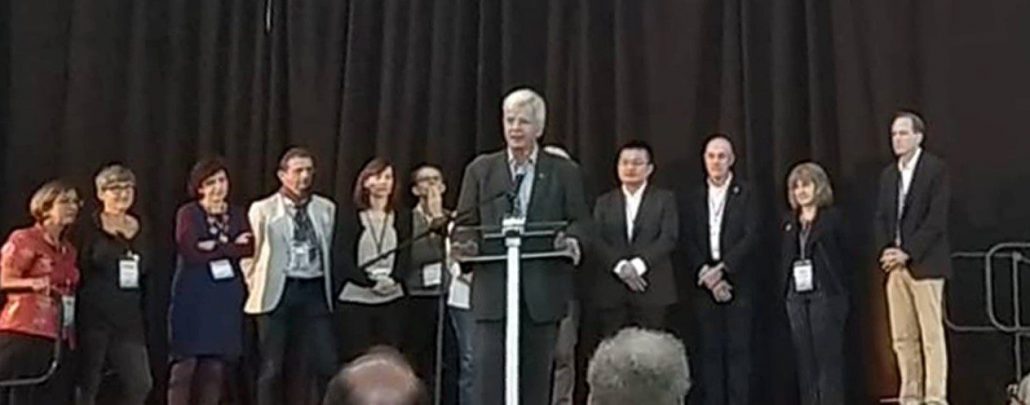
The CIPA Special Session was very well attended and 8 papers were presented followed by discussion. The CIPA Special Session was entitled 3D Documentation of Heritage (ICOMOS/ISPRS CIPA Special Session), and it was moderated by Prof Andreas Georgopoulos. The titles of the papers were:
- Image Processing Scheme for Archiving Epigraphs (Hideyuki Uesugi, Masayuki Uesugi and Teruhiro Tani);
- The digitisation of museum collections for research, management and enhancement of tangible and intangible heritage (Massimiliano Lo Turco, Fulvio Rinaudo, Paolo Piumatti, Michele Calvano, Alessandra Spreafico and Giacomo Patrucco);
- Roc-cut architecture: modeling Mahabalipuram (Alfonso Ippolito and Martina Attenni);
- Digital Documentation Workflow and Challenges for Tropical Vernacular Architecture in the Case of the Kasepuhan Palace in Cirebon, Indonesia (Arnadi Murtiyoso, Pierre Grussenmeyer, Deni Suwardhi, Dirga Sumantri, Shafarina Wahyu, Iwan Purnama, Sutrisno Murtiyoso, Gina Andryana and Rabby Awalludin);
- Rome under Rome: survey and analysis of the east excavation area beneath the Basilica Iulia (Marco Galli, Carlo Inglese, Tommaso Ismaelli and Marika Griffo);
- Image Base Modelling, 3D Laser scan & Gigapixel survey for the documentation of Carlo Lucangeli’s Flavian Amphitheater wood model (Graziano Mario Valenti and Jessica Romor);
- The critical reconstruction of the Temple – Theatre complex in the Italic Sanctuary of Pietrabbondante (Giorgia Potestà and Carlo Bianchini);
- Combining an Indoor positioning system (IPS) with Structure from Motion (SfM) techniques in cultural heritage (Panagiotis Parthenios)
The CIPA President was given the floor to welcome the participants during the opening ceremony and was again given the floor during the closing ceremony to advertise our next Symposium in Avila in 2019.
Andreas Georgopoulos
president@www.cipaheritagedocumentation.org
The CIPA International Symposium 2019 is Open for Paper Submission
Dear colleagues,
I would like to update you on our preparations for the CIPA International Symposium 2019 to be held in Ávila, Spain, 1-5 September. Please find below the most important information for your participation.

The registration for the CIPA International Symposium is now available here.
Papers
Papers in all areas of 3D recording, modelling, conserving, documenting, valorization and preservation of cultural heritage are invited. Please check the most important dates for submission here.
Tutorials
On Sunday 1st September and from 10 am to 2 pm, several tutorials will be offered at the Higher Polytechnic School of Ávila. Currently, confirmed topics include underwater photogrammetry, structural analysis by means of finithe elements, open-source web-based platforms, virtual and augmented reality as well as other new tools and technologies applied for Cultural Heritage inventory, management, restoration and conservation. To register for a tutorial, please do not forget to mark your Tutorial preference in the registration form. For further information please see click here.
Hotels
We have reserved a large number of hotel rooms for participants of the CIPA International Symposium 2019. Details on all hotels are provided here. We strongly recommend to book your hotel room as soon as possible since on September 6 the XXIII edition of the Medieval Market opens and Ávila will host many visitors during these days.
Social activities
The most emblematic places of Ávila: the Walls, the Cathedral, the Convent of St. Teresa and St. Vicent will be visited. In addition, congress attendes will be able to enjoy the Medieval Market and the International Circus Festival, two cultural events of recognized international prestige that will take place the weekend before and after the congress.
We’re looking forward to your participation in the CIPA International Symposium 2019!
On behalf of the local organising committee and all workshop convenors,
Wishing you all the best,
Fabio Remondino and Diego González-Aguilera, the congress Directors.

Fabio Remondino
remondino@fbk.eu
3dom.fbk.eu
CIPA summer school 2019
CIPA is happy to announce its 6th Heritage Documentation Summer School on “Cultural Heritage 3D Surveying and Modelling” which will take place from 14-20 July 2019 in Gyeongju, Republic of Korea. As with the past five editions, this summer school will consist of theoretical lectures (on photogrammetry/computer vision, laser scanning, photography and total station survey) and practical work, in the field and in the lab.
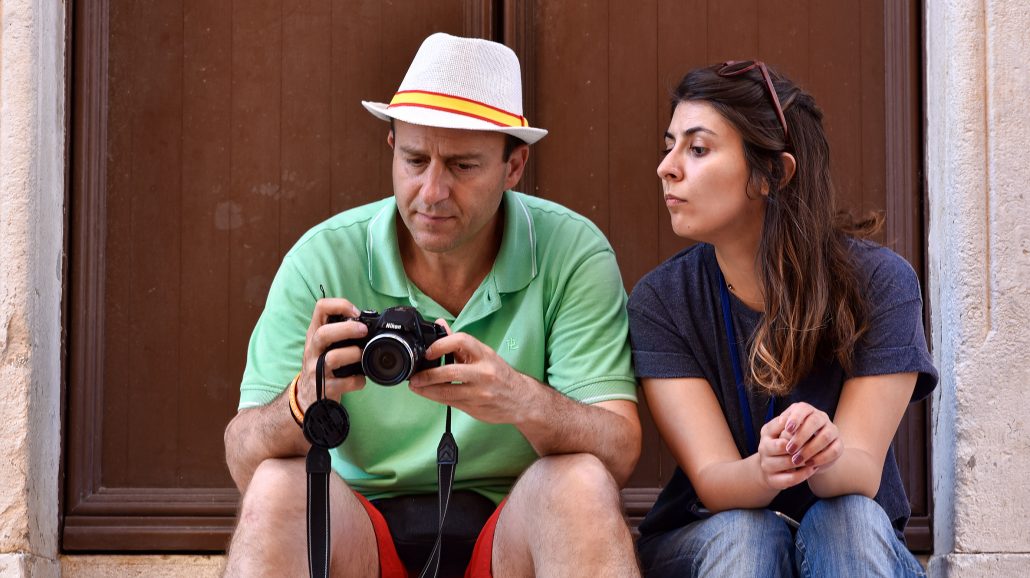
CIPA summer school in Zadar (2018). Photograph by Geert Verhoeven
The school is an opportunity for master and PhD students, researchers and practitioners, archaeologists, architects, restorers, conservationists and geomatic experts to get a thorough, well-structured theoretical introduction into 3D surveying and modelling for cultural heritage along with lots of practical hands-on experience with small artefacts and bigger archaeological structures.
More information about this summer school can be found in the following document.
Since this is will be the sixth summer school in a row, you can also find some impressions of past summer schools on our website as well as our YouTube channel.
ICOMOS Emerging Professionals Working Group (EPWG)
New CIPA representative
With the start of 2019, CIPA has appointed Rebecca Napolitano of Princeton University representative to the ICOMOS Emerging Professionals Working Group. A very promising and active scholar in the field of heritage recording.
The EPWG was established in 2017 in response to a call for expansion to the Emerging Professional membership base of ICOMOS. One of the main aims of this group is to become a platform where emerging professionals in the culture, conservation, and heritage industries can network with ICOMOS members and partner organizations. Since its inception, this group has been regularly involved with international projects such as the International Day for Monuments and Sites where they focused on fostering inter-generational dialogue through conferences, training sessions, round tables, and interactive tours among other methods. If you are not yet a member of ICOMOS and would like to join, please go here.
In future newsletters, there will be a dedicated section to updates from the working group and opportunities relevant to emerging professionals within CIPA. Opportunities will include but are not limited to academic openings, fellowships and grants, workshops, and professional development. Look out for this section in future newsletters! If you have relevant news or opportunities that you would like to contribute to this section, please reach out to Rebecca Napolitano.
For more information about the EPWG please see here and here.

Rebecca Napolitano
rkn2@princeton.edu
rebeccanapolitano.wordpress.com
A scholar opportunity in GCI
Mario Santana Quintero, Vice President of CIPA has been granted a Getty Conservation Institute’s (GCI) scholar opportunity to research about ethical principles for the application of Digital Workflows in Heritage Conservation (see also here). This work is based on utilizing the magnificent bibliographical sources of the Getty, as well as, interacting with the excellent scientific expertise of the GCI and reviewing projects. The outcome of this research is aimed at assisting heritage recording specialists in meeting ethical principles that will improve the role of digital information in the decision-making process for the conservation of heritage places.
Also, the ICOMOS Ethical principles will be used basis for the development of a framework for the preservation of digital records produced by these workflows that will transcend to future generations. Mario will be staying at the premises of the institute from January to March 2019. The preliminary results of the work will be revealed at CIPA Avila 2019 with the organization of an expert panel to discuss the issues of ethics in CIPA’s work.
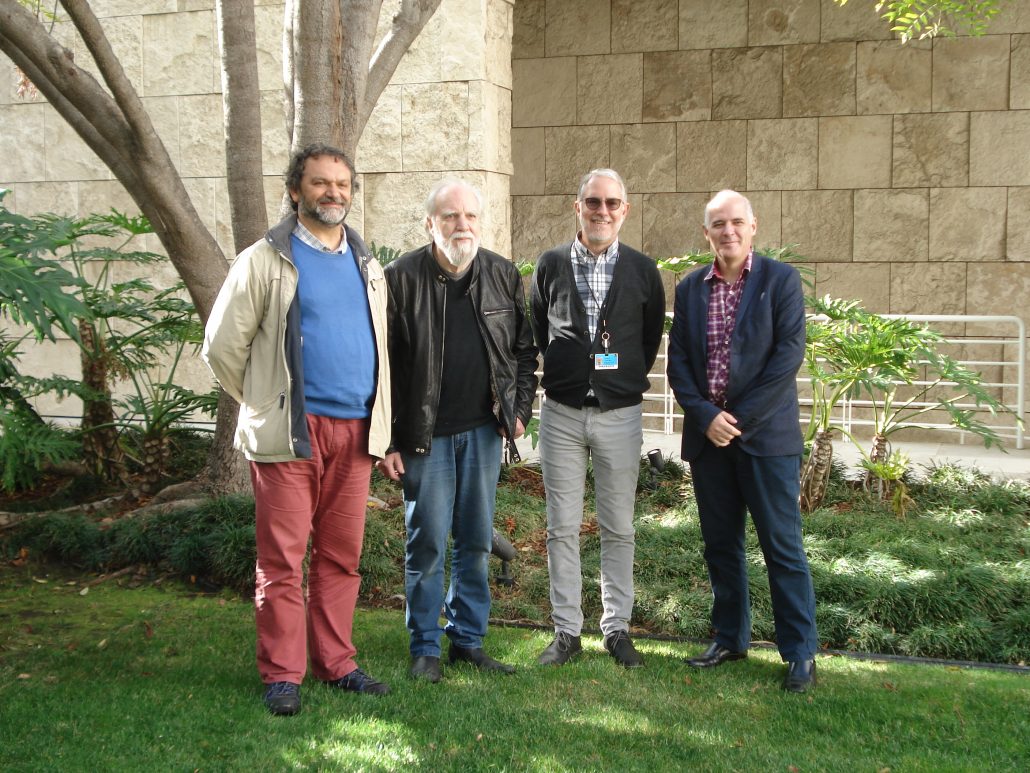
Photo by Giancralo Buzzanca with GCI Scholars 2019 (left to right): Giancarlo Buzzanca, Jonathan Ashley-Smith, Cameron Trowbridge (Manager, GCI Information Centre) and Mario Santana Quintero
Mario Santana
mario.santana@carleton.ca
New robotic arm for autonomous 3D scanning
The research lab CultLab3D has developed the new 3D scanning technology CultArm3D-P. The colour-calibrated robotic arm automatically scans the geometry and texture of previously unknown objects up to 50 cm in size, based on photogrammetry. The 3D results are of high-resolution (down to 30 µm) and generally do not require any post-processing.
Intelligent algorithms use a first scan to determine which others are needed subsequently. This allows the scan arm to independently plan the views required and capture any object with the optimum number of scans without the scanner having the CAD models. The result is a significantly reduced scan time of a maximum of 15 minutes. This unique feature makes CultArm3D-P the optimal and flexible solution to digitize any object in 3D.
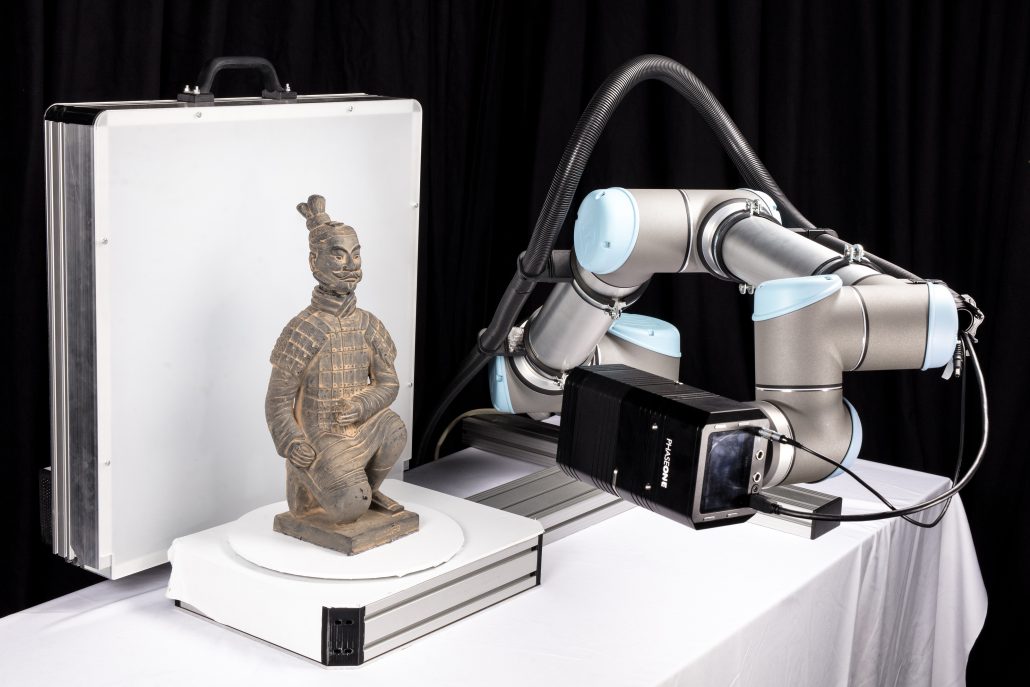
CultArm3D-P was exhibited for the first time at photokina, the leading international trade fair for the photo, video and imaging sector, taking place from 26-29 September 2018 in Cologne. The unique arm was presented with the new Phase One camera.
During the project »Digital World Views Online: 3D Models of Historical Globes,« the robotic arm scanner will be applied for the 3D acquisition of historical earth and celestial globes from the archives of the Friedrich Schiller University Jena and the Anna Amalia Library. The colorfast and detailed digitization allow the 800-years-old globes to be virtually accessible to enthusiasts.
For further specifications see here and here.
EU Prize for Cultural Heritage / Europa Nostra Award 2018 for CultLab3D!
In June 2018, CultLab3D was recognized with the EU Prize for Cultural Heritage / Europa Nostra Award 2018 in the category “research”. The ceremony of Europe’s most prestigious prize was taking place in the context of the European Heritage Year 2018 “Sharing Heritage” in Berlin, Germany – in the presence of the President of the Federal Republic of Germany Dr. Frank-Walter Steinmeier, and patron of the European Year of Cultural Heritage, European Commissioner Tibor Navracsics and Maestro Plácido Domingo.
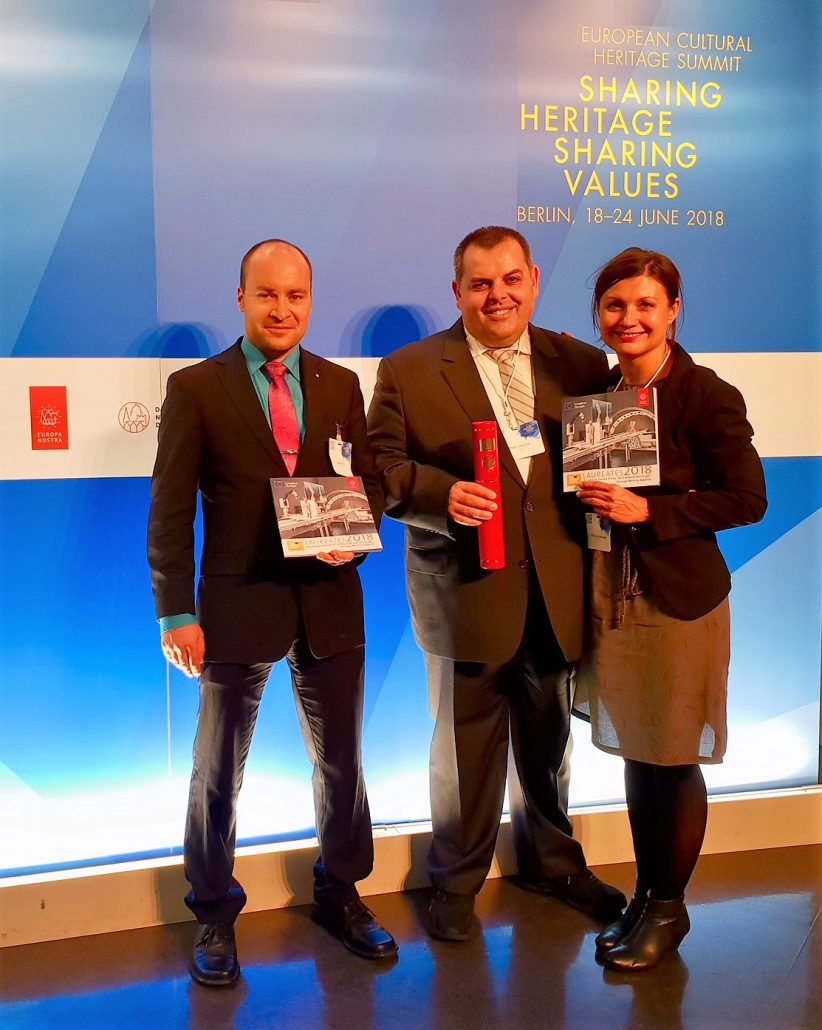
The accolade honoured the department for its innovative approach for 3D mass digitization and its outstanding achievements in preserving historic assets for Europa and its future generations to come.
The Europa Nostra Award recognizes notable achievements in the field of cultural heritage conservation. It highlights research, education and services by individuals or organizations to raise awareness for heritage protection. The award is supported by Europa Nostra, which awards the prize once in a year since 1978 and since 2002 together with the European Commission.
Further information:
Press Release Europa Nostra
Photos of ceremony
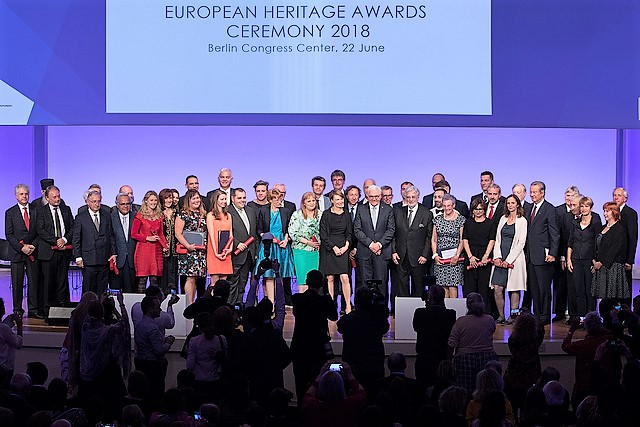
Constanze Fuhrmann
constanze.fuhrmann@igd.fraunhofer.de
www.cultlab3d.de
Arches Mobile Data Collection App
Available for Testing in Late February
The Getty Conservation Institute is pleased to announce that a new Arches Mobile Data-Collection Application is due to be released for testing in late February 2019 and will include the following features:
- Compatibility with Android and iOS devices;
- Support of data collection and temporary storage on devices when a network connection is not available;
- Synchronization of data (after offline activity) with your Arches instance;
- Ability to support user permissions. This will allow an Arches administrator to define access and update controls for volunteer/crowdsourcing data collection efforts;
The Arches Mobile App will work in conjunction with a comprehensive Arches Survey Manager tool within your Arches instance where you can control most aspects of data-collection/survey activities, which may also be used for crowd sourcing.
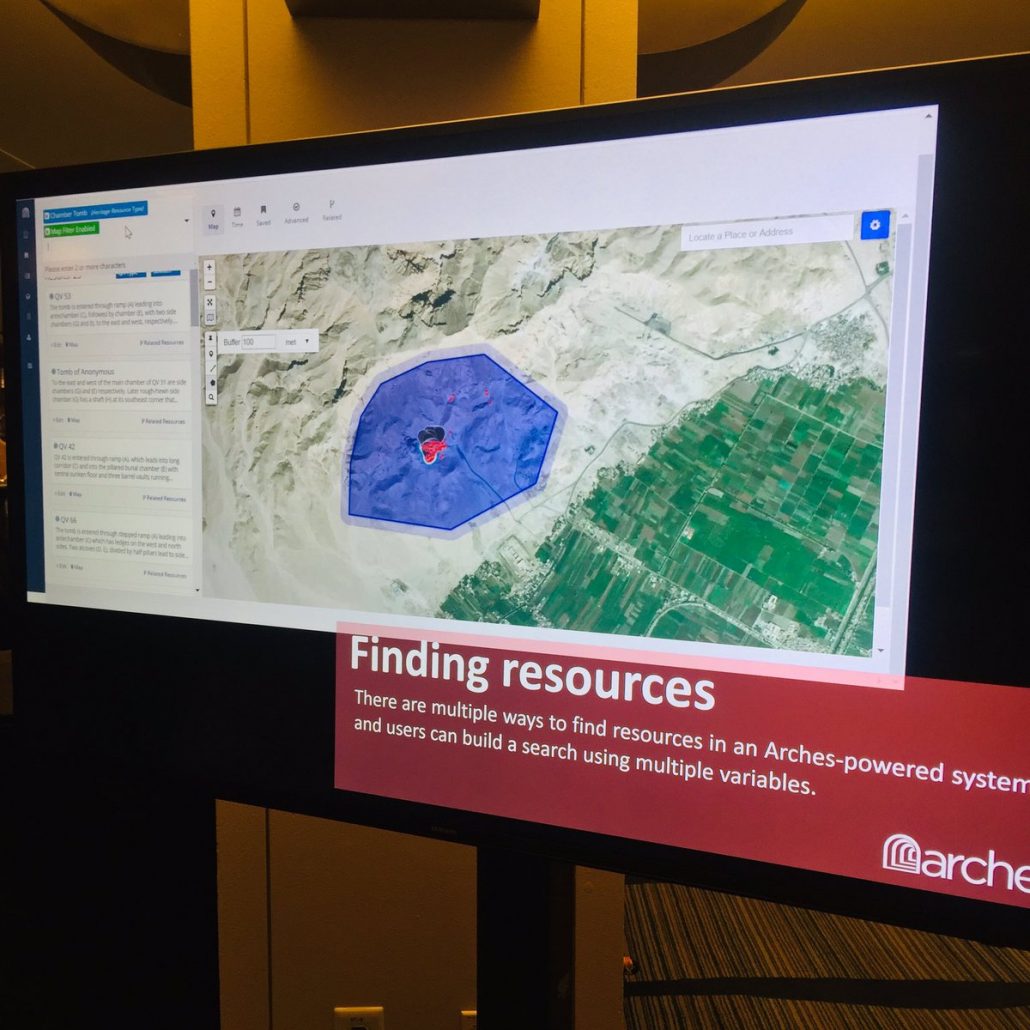
To receive announcements about this and other Arches news, sign up for the Arches announcement list here.
Also, read a review of the highlights of the Arches project in 2018, including new and planned implementations of the Arches platform.

Learn more about Arches here.
David Myers
dmyers@getty.edu
archesproject.org



